
DWDM system and the requirements of this system, the application of DWDM system:
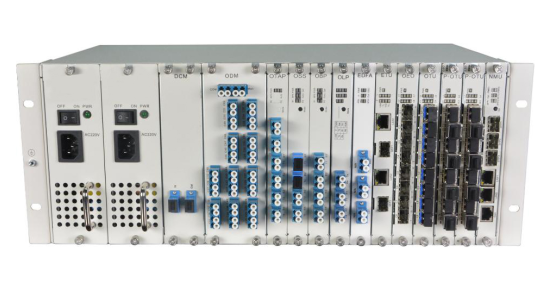
Introduction
A transmission technique used in fiber optics in which light wavelengths are used to transmit data either parallel by bit or serial by character is known as Dense Wavelength Division Multiplexing. Here dense means that the wavelength channels are very close to each other. The increasing demand of consumers lead to increased bandwidth and this is possible using DWDM. The data from various different sources is put together on optical fiber in which each signal travels at same speed on its own light wavelength. At the receiver end every channel is demultiplexed into original source therefore different data formats with different data rates such as Internet (IP) data, Synchronous Optical Network data (SONET), and asynchronous transfer mode (ATM) data can be transmitted together at the same time through optical fiber. Thus DWDM increases the network capacity and makes efficient use of bandwidth. The capability of transmission of DWDM is 4 to 8 times of TDM and here EDFA (Erbium doped optical amplifier) are deployed as these amplifiers boost the strength of signal and the signal need not be regenerated again and again. The signal can be transmitted to more than 300km before regeneration[1].
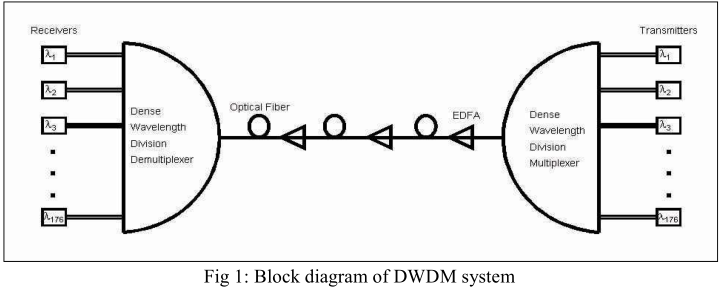
Bandwidth Demand
With the increasing applications like data transferring, media interactions, internet and other digital services the demand of bandwidth has also increased. The three possible solutions for the increasing bandwidth demand are:
1. Installation of new fibers.
2. New TDM technology in order to get high bit rates.
3. Use of Dense Wavelength Division Multiplexing.
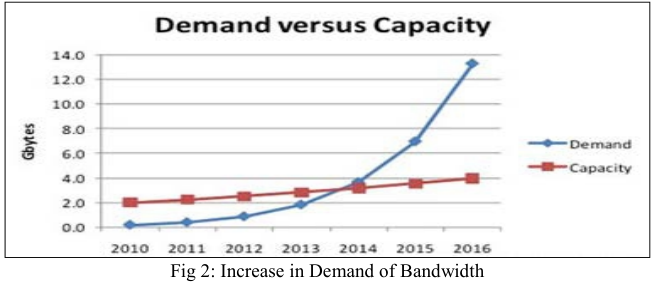
Installation of new fibers is difficult and costly. The estimated cost of deploying additional fiber cables is about $70,000 per mile [2]. The cost may vary from place to place but it is impractical to do so and there are various issues related to the use of new TDM technology. Thus the last possible solution is use of DWDM. The DWDM system uses a fiber pair, one for transmission and other for reception. Also a single fiber is used for bidirectional traffic. DWDM combines and transmits multiple signals on a same fiber simultaneously in a dense wavelength grid and thus increases the bandwidth capacity. DWDM can handle high bit rates at lower cost.
DWDM System
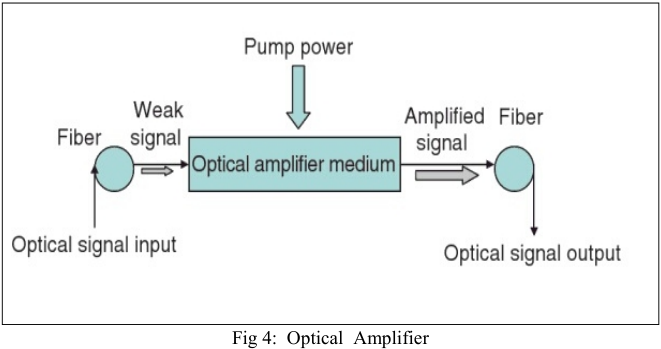
The input signal from input source i.e. laser is fed to the transponder which converts it to DWDM wavelength. This DWDM wavelength is multiplexed with signals to form a composite signal. This signal is then amplified and fed to fiber. OADM is used to add/ drop bit streams of particular wavelength. Before the signal reaches the de-multiplexer it is again amplified. This signal is then de-multiplexed to DWDM wavelengths. Thus the signal is fed to client end.
In case of dense wavelength division multiplexing the light travelling through the fiber is divided into wavelengths. A certain range of frequencies called window, are kept in mind while choosing the wavelength. DWDM basically does not increase the speed of travelling of data rather it sends the data in parallel in dedicated lanes. Each lane is independent from each other and thus traffic can travel at different speed. DWDM is capable of carrying 24 channels but in future the capacity is expected to increase to 128 channels in a single fiber.
A basic DWDM system consists of following components :
1. Transmitters/ Receivers: DWDM transmitters consist of a large number of transmission LASERs are multiplexed into a single fiber. A large number of individual lasers with different wavelengths are used to create individual channels of DWDM system [3]. Pulses of light are created by laser and each pulse has a particular wavelength (known as LAMBDA). A physical layer device is used to convert the incoming electrical signal to light signal. These pulses propagate through fiber using the phenomenon of total internal reflection. At the receiver end the light signal is converted to the electrical signal using an optical sensor called photodiode.
2. Optical amplifiers: The optical signal (light) can be amplified directly using optical amplifiers without first converting it to the electrical signal.These amplifiers add gain or boost the amplitude of optical signals by simulating the photons of signal with extra energy. EDFA are the optical repeaters that amplify the optical signal. The silica based optical fibers are doped with erbium to improve the power of wavelength.[4]
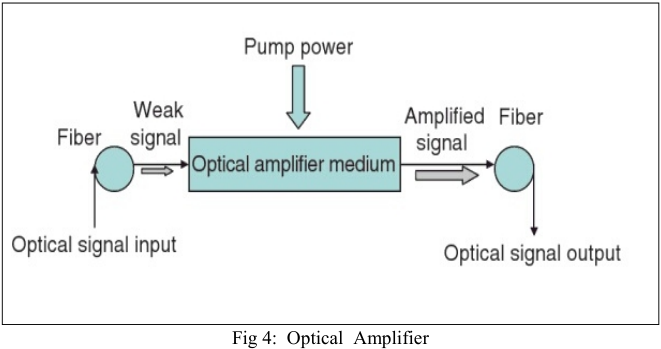
3. Optical Add/Drop multiplexers: The figure represents the operation
of one channel OADM. Here OADM is designed to add or drop signals with particular wavelength.
ADD means the capability of device to add new wavelength channel to
existing multi wavelength signal. DROP means to remove channel passing signal to another path. The incoming signal is broken into two components i.e. drop and pass through. The signal that is dropped is passed to the receiver of client device and the pass through signal is multiplexed with new signal stream. [5]
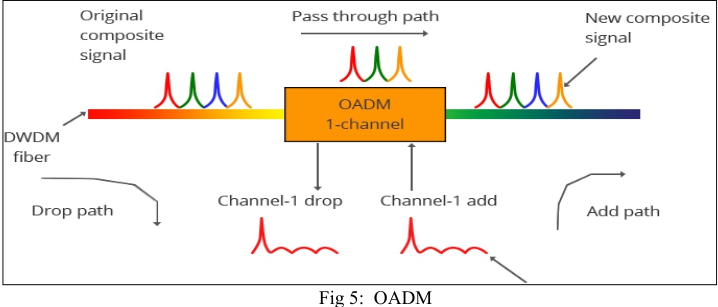
4. DWDM Multiplexers / De-multiplexers: Multiple wavelengths are
combined to be transmitted on one fiber and these form a composite signal. At the receiver end this composite signal is again separated into individual wavelengths using de-multiplexer. Optical multiplexer and de-multiplexer are passive components. Since the process of this multiplexing and de-multiplexing is optical thus there is no need of external power source.
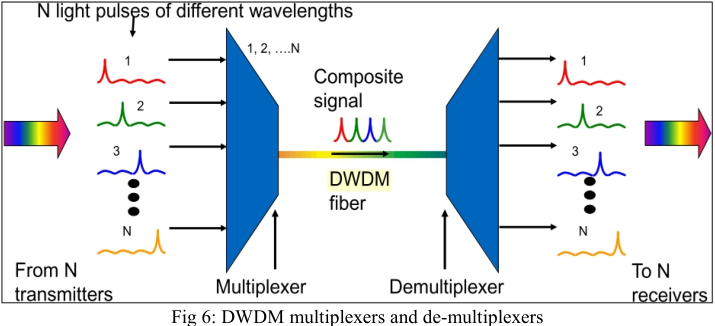
5. Transponder (wavelength converter): Transponder is a device that is used to send and receive signals from fiber and these are used to convert full duplex electrical signal to full duplex optical signal. These convert optical signal of one wavelength to optical signal of another wavelength suitable for DWDM applications. These are also known as optical ŌĆōelectrical-optical (O-E-O) wavelength converters. Thus these are useful for optical communication but these are bulky and consume more power.
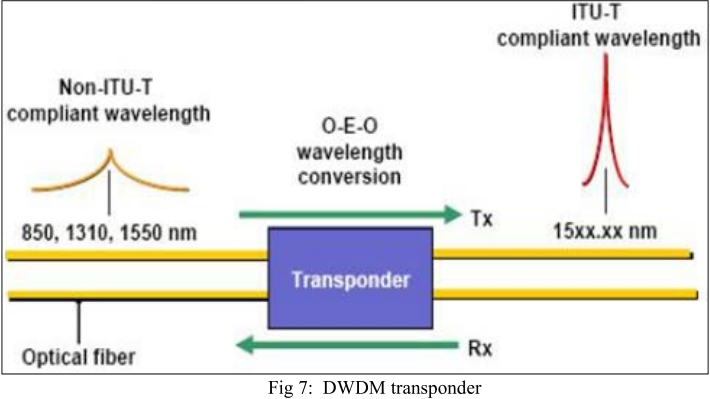
6. Applications of DWDM system:
1. DWDM has capability to expand capacity and can serve as backup
bandwidth without a need to install new fibers thus it is ready made for long distance telecommunication services.
2. DWDM can also be used in various networks like sensor networks,
remote radar networks, tele spectroscopic process control network and
many more networks.[6]
3. By the use of only two fibers 100% protected ring with 16 separate
communication signals, can be constructed deploying DWDM terminals as these are self healing rings. [6]
4. In order to meet the demand in fast growing industrial base DWDM
system can be used for existing thin fiber plants as these plants cannot
support high bit rates.
